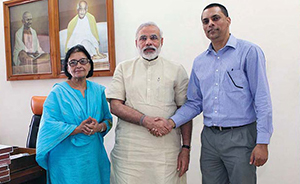A paradigm shift
Dr Prabhu Kulkarni explains the changing trade relationship between India and EU
Medical tourism is a rapidly developingnewindustry. The Confederation of Indian Industries (CII) estimates about 1.1 million foreigners travel to India each year for efficient and low cost treatments and surgeries. A heart bypass surgery costs $6,500 in a corporate hospital in India, as compared to $30,000 to $50,000 in the USA.
Since 2008 the industrialised economies of North America and Europe have been facing uncertain economic conditions. Their economies were undermined by unregulated banking systems and strong dependence on an overpriced construction industry. In spite of multibillion dollar bailouts and rescue measures, economic growth remains sluggish and the possibility of a double dip recession is looming heavily. Unemployment is rising fast creating social concerns that are likely to lead to restrictive practices, non-tariff trade barriers and protectionism. India's trade with North America and the EU is likely to face a bumpy ride with protectionist environments in two of its major trading regions. India's well-planned strategy over the last few years, of looking to the East (South-East Asia) and the southern hemisphere for increasing its global trade is paying handsome dividends.
China - India trade has crossed the $50 billion mark and is growing at about 20% to 30% annually. India's trade with South Africa, Brazil and a number of countries is the southern hemisphere is also growing rapidly.
EU-India trade has the potential to reach over €250 billion by 2015. Let's take a cursory glance at the trends in the EU-India trade:

Germany is India's largest European trading partner with 2009 trade worth $15.4 billion followed by France and the UK with about $6.8 and $6.3 billion, respectively. Though these numbers are growing, the share of EU trade with India is not expanding at the same rate as growth in India's total international trade.
At present, the position of theEU(a group of 27 countries), as the largest of India's trading partners, is seriously challenged by other regions. The UAE, with collective trade of US $ 96 billion in 2008-09, is now emerging as a block with larger trade prospects than the EU. In the same year, India has replaced China as the largest trading partner of the UAE. The Asia-Pacific region, including, China, Japan and the group 10 South-East Asian countries 'the ASEAN' will be India's largest trading partners. In 2009 China replaced the USA to become the largest trading country with India.
India has signed a collective Free TradeAgreement with 'ASEAN' and is in the process of finalising an FTA with Japan in October during the Prime Minister Dr Manmohan Singh's visit to Japan.
For the last few years, negotiations have been in progress to draft an EU- India Trade Agreement. However, since 2007 these negotiations have stumbled due to various insurmountable issues and are lurching from high optimism to stagnation.
The EU-India FTAis an essential step in advancing mutual trade. It will require sophisticated negotiating skills and serious compromises on both sides. Entrenched attitudes and resistance to transform outdated trade practices and financial institutions will hamper FTAnegotiations.
The issues and their consequences will have lasting effects on the survival of millions of poor people in India and the rest of the world and hundreds of thousands of jobs in the EU.
—Dr Prabhu Kulkarni is the president of Gopio Ireland & India Director, Irish Exporters Association -Asia Pacific Trade Forum










Comments.